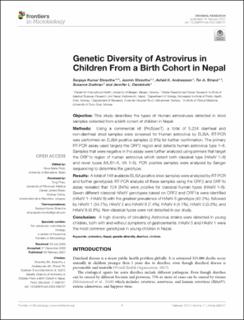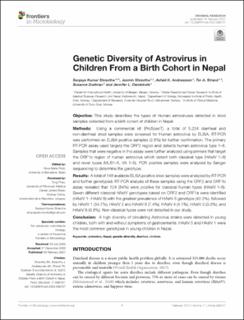| dc.contributor.author | Shrestha, Sanjaya Kumar | |
| dc.contributor.author | Shrestha, Jasmin | |
| dc.contributor.author | Andreassen, Åshild Kristine | |
| dc.contributor.author | Strand, Tor A | |
| dc.contributor.author | Dudman, Susanne Gjeruldsen | |
| dc.contributor.author | Dembinski, Jennifer Lynn | |
| dc.date.accessioned | 2022-03-30T06:15:21Z | |
| dc.date.available | 2022-03-30T06:15:21Z | |
| dc.date.created | 2021-02-23T09:33:22Z | |
| dc.date.issued | 2021 | |
| dc.identifier.citation | Frontiers in Microbiology. 2021, 11 1-9. | |
| dc.identifier.issn | 1664-302X | |
| dc.identifier.uri | https://hdl.handle.net/11250/2988445 | |
| dc.description.abstract | Objective: This study describes the types of Human astroviruses detected in stool samples collected from a birth cohort of children in Nepal. Methods: Using a commercial kit (ProSpecT), a total of 5,224 diarrheal and non-diarrheal stool samples were screened for Human astrovirus by ELISA. RT-PCR was performed on ELISA positive samples (2.8%) for further confirmation. The primary RT-PCR assay used targets the ORF2 region and detects human astrovirus type 1–8. Samples that were negative in this assay were further analyzed using primers that target the ORF1b region of human astrovirus which detect both classical type (HAstV 1–8) and novel types (MLB1–5, VA 1–5). PCR positive samples were analyzed by Sanger sequencing to determine the genotype. Results: A total of 148 available ELISA positive stool samples were analyzed by RT-PCR and further genotyped. RT-PCR analysis of these samples using the ORF2 and ORF1b assay revealed that 124 (84%) were positive for classical human types (HAstV 1–8). Seven different classical HAstV genotypes based on ORF2 and ORF1a were identified (HAstV 1- HAstV 8) with the greatest prevalence of HAstV 5 genotype (42.2%), followed by HAstV 1 (34.7%), HAstV 2 and HAstV 8 (7.4%), HAstV 4 (4.1%), HAstV 3 (3.3%), and HAstV 6 (0.8%). Non-classical types were not detected in our study. Conclusion: A high diversity of circulating Astrovirus strains were detected in young children, both with and without symptoms of gastroenteritis. HAstV 5 and HAstV 1 were the most common genotypes in young children in Nepal. | |
| dc.language.iso | eng | |
| dc.title | Genetic diversity of astrovirus in children from a birth cohort in Nepal | |
| dc.type | Peer reviewed | |
| dc.type | Journal article | |
| dc.description.version | publishedVersion | |
| dc.description.version | publishedVersion | |
| dc.source.pagenumber | 1-9 | |
| dc.source.volume | 11 | |
| dc.source.journal | Frontiers in Microbiology | |
| dc.identifier.doi | 10.3389/fmicb.2020.588707 | |
| dc.identifier.cristin | 1892622 | |
| dc.relation.project | Norges forskningsråd: 223269 | |
| cristin.ispublished | true | |
| cristin.fulltext | original | |
| cristin.fulltext | original | |
| cristin.qualitycode | 2 | |

